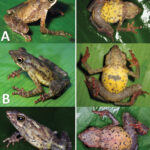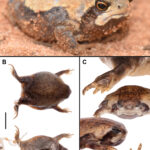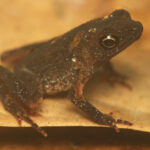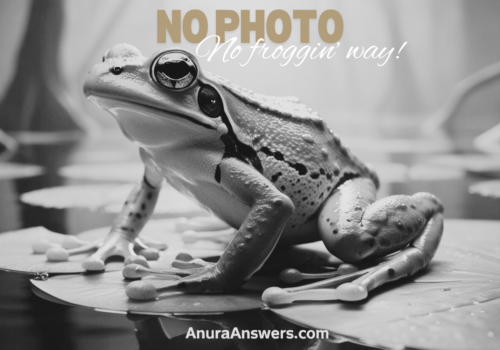Atelopus lynchi: Unveiling the Secrets of Lynch’s Harlequin Frog#
Deep within the emerald tapestry of Ecuador’s pristine cloud forests resides a creature whose quiet existence embodies both the fragility and resilience of life—Atelopus lynchi, known commonly as Lynch’s Harlequin Frog. This alluring amphibian, draped in hues of gold, black, and green, remains hidden beneath dense foliage and moss-draped limbs, moving softly through the leaf litter like a tiny phantom of the rainforest. Beyond its decorative beauty and subtle presence lies a captivating tale of survival, adaptation, and the urgent call to protect one of nature’s most delicate jewels from extinction.
Named affectionately after famed herpetologist John Douglas Lynch, this species belongs to the toad family Bufonidae, inhabiting a narrow ecological niche that makes it both fascinating and particularly vulnerable. Despite its diminutive stature, Atelopus lynchi serves as a powerful indicator of ecosystem health, signaling shifts within its fragile habitat long before human eyes detect them.
Intriguingly, Lynch’s Harlequin Frog has quietly become a symbol of hope and despair intertwined, as conservationists vigorously battle the looming threats that endanger its survival. By learning about this species, we uncover far more than an amphibian’s biography—we journey into the depths of cloud forests, exploring both their wonder and vulnerability.
Taxonomy and Classification#
Before venturing deeper into the cloud forest’s misty canopy, let’s briefly examine its biological identity. Atelopus lynchi belongs to the genus Atelopus, a distinct and fascinating group of amphibians known as Harlequin frogs or toads due to their vivid coloration and intricate patterns. Falling under the family Bufonidae, this frog shares ancestral roots with many familiar toads worldwide, but its distinctive appearance and highly specialized lifestyle set it apart.
The genus Atelopus comprises over 90 species, many of them renowned for their striking patterns and poignant vulnerabilities. Lynch’s Harlequin Frog itself was formally described and brought into scientific discovery by the distinguished Ecuadorian amphibian biologist Luis Coloma in 1994, making it comparatively understudied and deeply intriguing to biologists.
This compelling family finds evolutionary cousins everywhere from lush mountainous habitats to lowland rainforests, yet each member, including our spotlight species, has developed particular traits finely tuned to their respective environment, forming a beautifully diverse amphibian mosaic across tropical America.
Natural Habitat#
Imagine stepping into the luxuriant cloud forests of the Ecuadorian Andes, a realm enveloped in perpetual mist, scented with damp earth and rich moss. Here, among the towering trees draped in tangled vines and orchids, Atelopus lynchi quietly thrives beneath the dew-soaked leaves.
Geographic Range and Distribution#
Native exclusively to Ecuador, this frog’s distribution is restricted to small, secluded localities in montane forests along the western slopes of the Andes. Most recorded sightings are documented within the provinces of Cotopaxi and Pichincha, an area characterized by mountainous terrain marked with numerous streams, waterfalls, and steep valleys.
This limited distribution underscores an important aspect of their vulnerability, as any ecological disturbance within these delicate habitats reverberates significantly through their small, isolated populations.
Habitat Preferences and Microhabitat#
Unlike many amphibians, Lynch’s Harlequin Frog prefers habitats close to running water, occupying the moist margins of streams and rivulets cutting through thick, subtropical cloud forests. Moss-covered rocks, dense leaf litter carpets, and vegetation adjacent to flowing streams provide them ideal hunting grounds abundant with insects and shelter from predators.
The intricate microhabitats of mossy riverbanks afford these delicate creatures suitable humidity levels, vital refuge, and optimal egg-laying environments. Humidity regulation is crucial in these high-altitude environments, and microclimate stability gives Atelopus lynchi its best chance to thrive amidst challenging conditions.
Physical Characteristics#
Lynch’s Harlequin Frog captivates observers with a vibrant color palette that blends elegance and practicality seamlessly. Measuring roughly 30-45 millimeters, females tend to exhibit slightly larger sizes compared to males—a trait common among many amphibian species.
The most striking feature of Atelopus lynchi is undoubtedly its skin coloration. Its name “harlequin” alludes directly to the delightful patterning: bold patterns of yellow, orange, and golden-green contrast starkly against darker shades of brown, green, and black. These mosaic-like markings are not merely ornamental; they serve as a natural camouflage amidst color-splashed forest floors, protecting them from opportunistic predators such as birds or small mammals.
The frog’s physiology beautifully complements its surroundings. Long, slender limbs allow purposeful yet delicate leaps, navigating efficiently through complex microhabitats. Their smooth, slightly granular skin is adapted impeccably to absorb moisture and regulate their internal water balance, critical in the mist-laden montane climate.
Behavior and Life Cycle#
Understanding the everyday life of Lynch’s Harlequin Frog brings us deeper into their exceptional niche adaptations, highlighting behaviors that amaze herpetologists and conservationists alike.
Feeding Habits and Diet#
As insectivores, Lynch’s Harlequin frogs hunt primarily small invertebrates, preying upon beetles, ants, flies, mites, and other arthropods that venture too close to their territories. Equipped with sharp vision and excellent sensitivity to vibration, the frogs employ patient ambush tactics, remaining motionless until prey is within striking range, swiftly lunging with remarkable accuracy to secure their meals.
Mating and Reproduction#
When seasonal rains drape the forests with deeper moisture, it signals the onset of mating rituals. Males emerge prominently onto stream-side perches, broadcasting melodic, faintly musical mating calls to attract receptive females seeking partners.
Once coupled, stringently observed courtship rituals follow. The females deposit gelatinous egg masses under submerged stones or within shallow pools along quieter streamside stretches. Interestingly, unlike many of their amphibious cousins, parental care behaviors in Harlequin frogs tend to be minimal, with nature meticulously adopting these eggs and later tadpole developments into the protective embrace of clear mountain streams.
Ecological Role#
Within the lush tapestry of cloud forests, Lynch’s Harlequin Frog fulfills a crucial ecological niche. Through predation, it regulates insect populations, maintaining balance within the ecosystem. In turn, it serves as prey for larger species including birds, reptiles, and small mammals, representing sustaining links within the forest’s complex food web.
Due to their sensitivity to even minor environmental changes, scientists consider this frog an exceptional “indicator species,” offering valuable early warnings about ecosystem health, biodiversity loss, and potential ecological disruption before more visible signs appear.
Threats and Conservation Status#
Alarmingly, the existence of Atelopus lynchi is fraught with threats intensified by human activity and climate change. Habitat destruction from logging, agriculture, and sprawling urban developments fragments their already limited range, forcing populations into increasingly smaller pockets of viable habitat. Moreover, pollution via pesticides and contamination of waterways severely impacts reproduction and larval stages, substantially reducing survival chances.
Worse yet, amphibians globally—and harlequin frogs specifically—face a catastrophic epidemic: the lethal chytrid fungus (Batrachochytrium dendrobatidis). This fungal pathogen has decimated populations across the globe, posing a dire existential risk for vulnerable species like Lynch’s Harlequin Frog.
Recognizing these combined threats, Atelopus lynchi is currently listed as Critically Endangered on the IUCN Red List, underscoring the imperative for intensive conservation interventions and protective legislation to avoid irreversible extinction.
Cultural and Scientific Significance#
Beyond biological fascination, this tiny amphibian embodies symbolic resonance and cultural significance. Indigenously, frogs symbolize transformation and cleansing in Andean folklore, reminders of remarkable ecological connectivity between cultural beliefs and biodiversity.
Furthermore, scientists investigating harlequin frogs have highlighted their potent skin toxins, novel biochemical compounds with considerable pharmacological potential in medicinal and scientific research.
Conclusion#
In learning about Lynch’s Harlequin Frog, we come face-to-face with an emblematic tale of survival, adaptation, but also great precariousness. Atelopus lynchi reveals humanity’s profound interconnectedness with nature, illuminating the invisible threads joining ecosystems, species, and human actions together inextricably. Now more than ever, their preservation requires our awareness and collective embrace of meaningful conservation actions—before their silent, magical chorus fades into silence forever.







